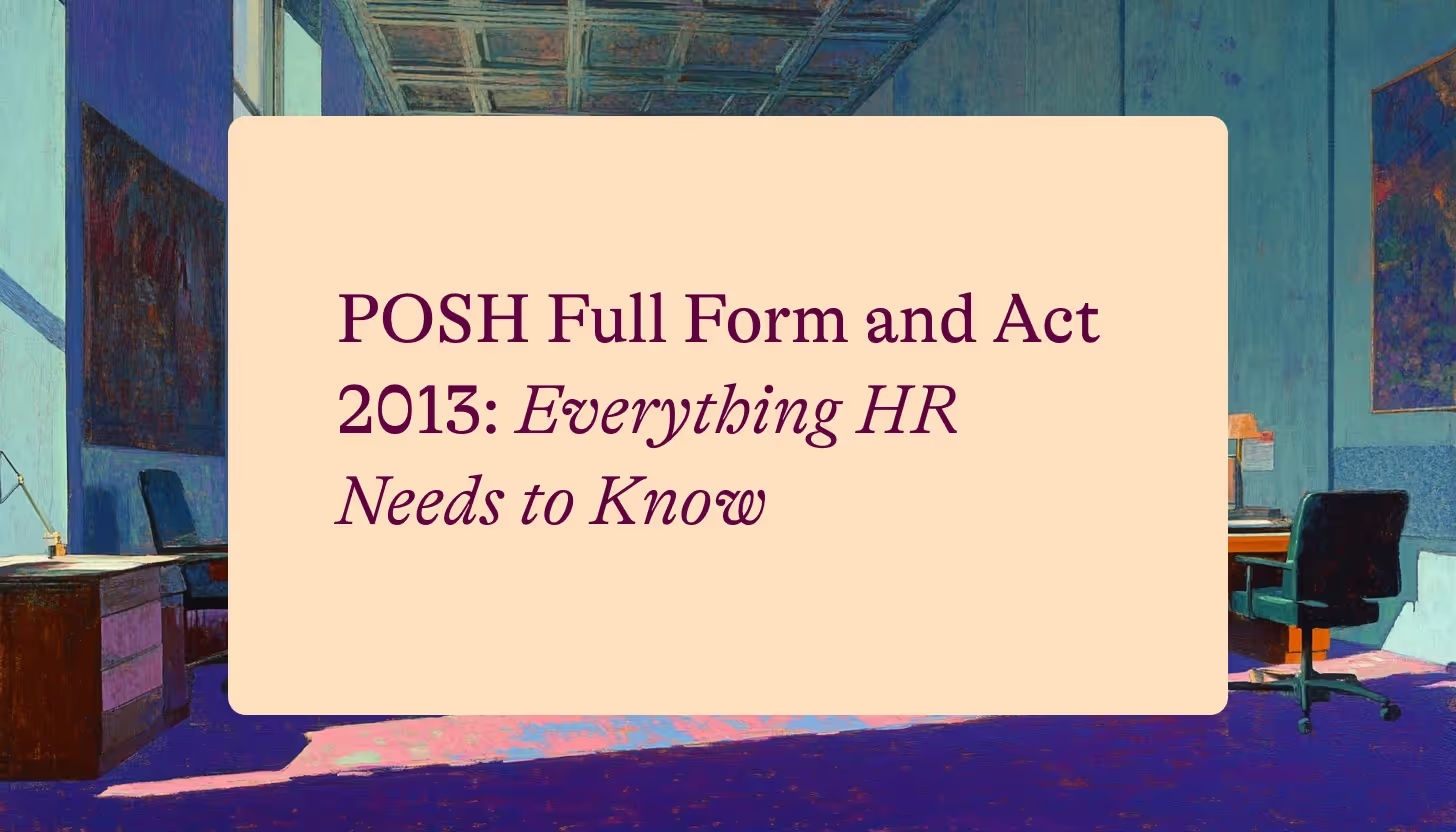HR analytics is the process of collecting, analysing, and interpreting HR data to support smarter, faster, and more strategic decisions. Instead of running parallel to business strategy, HR becomes a co-author of it. It stops being the department that reports what happened and becomes the one that explains why it happened — and even predicts what will happen next.
HR used to be described as the “people function.” Today, it is also the “evidence function.” With rapid changes in the workplace — hybrid models, rising medical inflation, higher employee expectations, and the need for fair, data-backed decision-making — HR teams can no longer rely solely on experience or instinct. They need clarity. They need foresight. And that’s exactly what HR analytics provides.
This guide unpacks HR analytics from definition to execution: what it means, why it matters, the metrics that shape it, and what Indian HR teams can do to use analytics as a competitive advantage.
Even experienced HR teams can find themselves tangled in overlapping terminology. Words like HR analytics, people analytics, workforce analytics, and HRIS are often used interchangeably — which creates confusion when selecting tools, designing strategy, or reporting to leadership. This section clarifies these distinctions so HR teams can choose the right approach for their organisation.
What is HR Analytics?
At its simplest, HR analytics is the practice of measuring how HR activities influence organisational performance. It connects HR metrics — like retention rate, absenteeism, time to hire, utilisation of employee benefits, or training effectiveness — with business indicators such as productivity, profitability, risk, and long-term strategic health.
This is where HR analytics becomes powerful. It isn’t just reporting numbers; it’s calculating how human capital investments translate into revenue, save costs, reduce compliance risk, or strengthen leadership pipelines. It blends statistical techniques with integrated HR, financial, and operational data to generate insights that help organisations design better workforces and better workplaces.
HR Analytics vs People Analytics vs Workforce Analytics
Despite sounding similar, these terms serve different purposes.
HR Analytics focuses narrowly on HR-managed data — things like hiring efficiency, training spend, performance distribution, and cost-per-hire. Its goal is to improve HR processes and outcomes.
People Analytics stretches further. It includes employees, candidates, customers, vendors — anyone whose behaviour affects business outcomes. It integrates data from finance, sales, customer satisfaction, and even product usage to solve broader organisational problems.
Workforce Analytics sits somewhere in between. It is employee-centric, covering the entire workforce ecosystem: full-timers, contract staff, freelancers, and gig workers. In many organisations, it overlaps naturally with HR analytics.
Understanding these distinctions helps HR teams choose the right lens rather than crowding dashboards with unrelated data.
HR Analytics vs HRIS
An HRIS (Human Resource Information System) is the engine room — where employee data is stored, organised, and updated.
HR analytics, on the other hand, is what turns that data into strategy.
If HRIS is the filing cabinet, HR analytics is the interpretation, analysis, and decision-making that happens after the data is pulled out of the drawer.
Driving Business Value: The Importance of HR Analytics
Organisations no longer see HR analytics as a side function. It has become a strategic necessity — especially in India, where fast-scaling teams, rising healthcare costs, and talent shortages require more precise decision-making.
HR analytics drives value in several ways:
Strategic Alignment
Data reveals how HR contributes directly to organisational goals — whether that’s faster hiring for new markets, reducing attrition in high-impact roles, or strengthening leadership bandwidth.
Improved Outcomes Across the Employee Lifecycle
Analytics shows where processes break down: onboarding inconsistencies, ineffective training modules, poor manager-employee dynamics, low engagement pockets, or escalating burnout.
Cost Reduction and Efficiency
From overtime costs to healthcare utilisation, analytics highlights inefficiencies that silently drain budgets.
Proactive Planning
HR teams can anticipate disruptions — such as rising absenteeism, skill shortages, or impending attrition — long before they become business emergencies.
Measuring ROI of Talent Investments
Analytics quantifies the impact of reskilling programs, leadership academies, diversity initiatives, and wellbeing interventions.
In short: HR analytics turns people decisions into business decisions.
The Four Types of HR Analytics
As organisations mature, they move through different levels of analytical sophistication. Each type answers a different question.
1. Descriptive HR Analytics
What happened?
This looks at historical data — annual turnover, monthly absenteeism, or performance spreads.
2. Diagnostic HR Analytics
Why did it happen?
It investigates drivers: for example, correlating high attrition with poor manager ratings, long commute times, or excessive workloads.
3. Predictive HR Analytics
What will happen next?
Uses statistical models to forecast outcomes — such as likelihood of an employee resigning or the roles most likely to face shortages next quarter.
4. Prescriptive HR Analytics
What should we do now?
This is the most advanced stage: algorithms recommend actions like customised onboarding for new hires or targeted retention plans for high-risk employees.
Together, these layers help HR move from reactive to preventative to strategic.
Key HR Metrics and KPIs to Measure
HR analytics relies on high-quality metrics. The right KPIs not only reflect workforce health but also signal where HR can intervene for maximum impact.
Financial & Productivity Metrics
Metrics such as revenue per employee, training cost per employee, and training effectiveness tell a clear story about organisational efficiency. For example, a spike in revenue per employee can validate recent changes in job design or workforce optimisation.
Talent Acquisition Metrics
Time to hire, time to fill, offer acceptance rate, and cost-per-hire help HR improve sourcing, strengthen employer branding, and reduce recruitment bottlenecks.
Retention & Experience Metrics
Voluntary vs involuntary turnover, absenteeism trends, and eNPS give visibility into culture, morale, and leadership effectiveness. Rising voluntary turnover often indicates unmet expectations rather than purely external market movement.
Risk Metrics
Human capital risk and diversity metrics highlight vulnerabilities — whether that’s lack of succession bench strength, dependency on a single skill group, or inconsistent representation across levels.
These metrics, when analysed together rather than in isolation, help HR identify patterns, gaps, and opportunities for intervention.
Data Sources and Infrastructure
High-quality analytics begins with high-quality data.
Internal Data Sources
HR departments gather rich information: performance reviews, training history, compensation, tenure, manager assessments, and succession plans. These datasets form the backbone of HR analytics.
External Data Sources
Complementing internal data with financial statistics, operational metrics, industry benchmarks, social sentiment, and even macroeconomic indicators provides context — critical for accurate interpretation.
External datasets explain why internal patterns emerge, not just what they are.
The HR Analytics Cycle: How to Get Started and Drive Change
Successful HR analytics operations follow a clear, repeatable cycle.
1. Ask a Relevant Business Question
Start with outcomes, not dashboards:
“Which employees have the highest leadership potential?”
“How do we reduce early attrition?”
“Which benefits have the highest utilisation and impact?”
2. Data Selection
Identify which datasets answer the question — HRIS, attendance, finance, surveys, or even health claims data.
3. Data Cleaning
Errors, duplicates, and missing entries can distort insights. Cleaning ensures analysis stays reliable.
4. Data Analysis
Statistical techniques reveal relationships, trends, clusters, and anomalies. Tools can range from Excel to Python scripts depending on maturity.
5. Actionable Insights
Insights must translate into decisions — improved onboarding, targeted development plans, redesigned benefits, or more equitable pay structures.
This cycle builds consistency and credibility within the organisation.
Best Practices for Implementation and Maturity
As HR teams deepen their analytics capabilities, these practices help accelerate adoption.
Strategic Collaboration
Partner with leadership to align analytics with organisational priorities.
Bring in Data Scientists
Their statistical expertise strengthens models, validates assumptions, and helps HR tell data-driven stories.
Start Small
Pilot projects — like predicting new joiner attrition or analysing benefits utilisation — build confidence and demonstrate business value.
Ensure Ethical & Legal Compliance
Employee privacy, consent, and data security must remain central to analytics efforts.
Invest in the Right Tools
Cloud-based systems with dashboards, predictive modules, and intuitive reporting make analytics accessible to teams with varying skill levels.
Together, these best practices create an organisation-wide data culture.
The Future of HR: Upskilling and Strategic Partnership
HR analytics has created an entirely new career track. Roles like HR Analytics Manager, People Insights Lead, and Workforce Strategist are becoming critical hires as companies scale. Certifications in data visualisation, statistical analysis, and business storytelling are fast becoming expected competencies.
More importantly, HR analytics elevates HR from support function to strategic partner. HR professionals who can read patterns, link them to business strategy, and influence leadership decisions will play defining roles in their organisations’ future.
By combining empathy with evidence, HR becomes both the voice of the employee and the compass for the business.
.avif)








.avif)
















